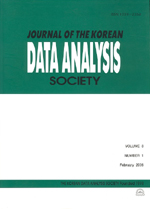구조방정식모형을 이용한 심리적 안녕감과 주관적 안녕감의 관계 분석
The Relations between Factors of Psychological and Subjective Well-being using Structural Equation Model
- 한국자료분석학회
- Journal of The Korean Data Analysis Society (JKDAS)
- Vol.12 No.3
-
2010.061321 - 1338 (18 pages)
- 92

심리적 안녕감과 주관적 안녕감에 대한 연구는 심리학적인 이론에 바탕을 두고서 그 구성개념의 속성과 연관성에 대한 연구가 주류를 이루어 왔다. 하지만 실증적인 측면에서 바라보면 측정문항의 신뢰도 및 타당도에 있어서 문제가 있음이 발견된다. 본 연구에서는 심리학적인 이론 뿐만 아니라 데이터 분석적인 측면에서도 좀 더 현실적인 방법으로 심리적 안녕감과 주관적 안녕감의 관계를 살펴보고자 하였다. 이를 위하여 척도에 대한 신뢰도 및 타당도와 더불어 다중회귀분석 방법과 요인분석 방법을 결합한 구조방정식모형을 사용하여 심리적인 안녕감과 주관적 안녕감의 관계를 살펴보았다. 분석결과 삶의 만족도와 긍정적 정서경험에는 자아수용이 가장 큰 영향을 미치고, 부정적 정서경험에는 자율성이 가장 큰 영향을 미치는 것으로 나타났다. 연구결과를 토대로 시사점 및 한계점을 제시하였다.
The main stream of research on psychological and subjective well-being has been focusing on the characteristics of their constructs and associations among them. However, some problems could be found in the reliability and validity with a point of view of data oriented research. In this research, the relations between psychological and subjective well-being are analyzed by realistically combining psychology theory and data analytic research. Structural Equation Model combining multiple regression model and factor analysis accommodating measurements errors simultaneously are used to verify the relations between psychological and subjective well-being. It has been found that life satisfaction and positive affection are mainly influenced by self acceptance, and negative affection is mainly influenced by autonomy. The limitations and suggestions are discussed for further research.
1. 서론
2. 이론적 배경
3. 연구방법
4. 실증분석
5. 결론 및 토의
참고문헌
(0)
(0)